engine coolant Oldsmobile Achieva 1997 Owner's Manuals
[x] Cancel search | Manufacturer: OLDSMOBILE, Model Year: 1997, Model line: Achieva, Model: Oldsmobile Achieva 1997Pages: 372, PDF Size: 18.52 MB
Page 7 of 372

Vehicle Symbols
These
are some of the symbols you may find on your vehicle.
For example,
these symbols
are used
on an
original battery:
POSSIBLE A
CAUTION
INJURY
PROTECT EYES BY
SHIELDING
CAUSTIC
BURNS AVOID
SPARKS
OR
FLAMES
SPARK
OR ,\I/,
COULD FLAME
EXPLODE BATTERY
These symbols are important
for you and
your passengers
whenever your
vehicle
is
driven:
DOOR LOCK
UNLOCK
4
BELTS
n
POWER
WINDOW 'tl
These symbols have
to do wilh
your lamps:
SIGNALS e e
TURN
RUNNING
.'****o
DAYTIME LAMPS
'**
FOG LAMPS $0
These symbols
are
on some of
your controls:
WINDSHIELD
WIPER
WINDSHIELD DEFROSTER
WINDOW
DEFOGGER
VENTILATING FAN
These symbols
are used on
warning and
indicator
lights:
COOLANT -
TEMP -
CHARGING I-1
BAlTERY
SYSTEM
BRAKE
(@)
ENGINE OIL w,
PRESSURE
ANTI-LOCK
(@)
BRAKES
Here are some other symbols
you may see:
FUSE -%-
LIGHTER n
HORN )tr
SPEAKER
b
FUEL e3
Page 57 of 372
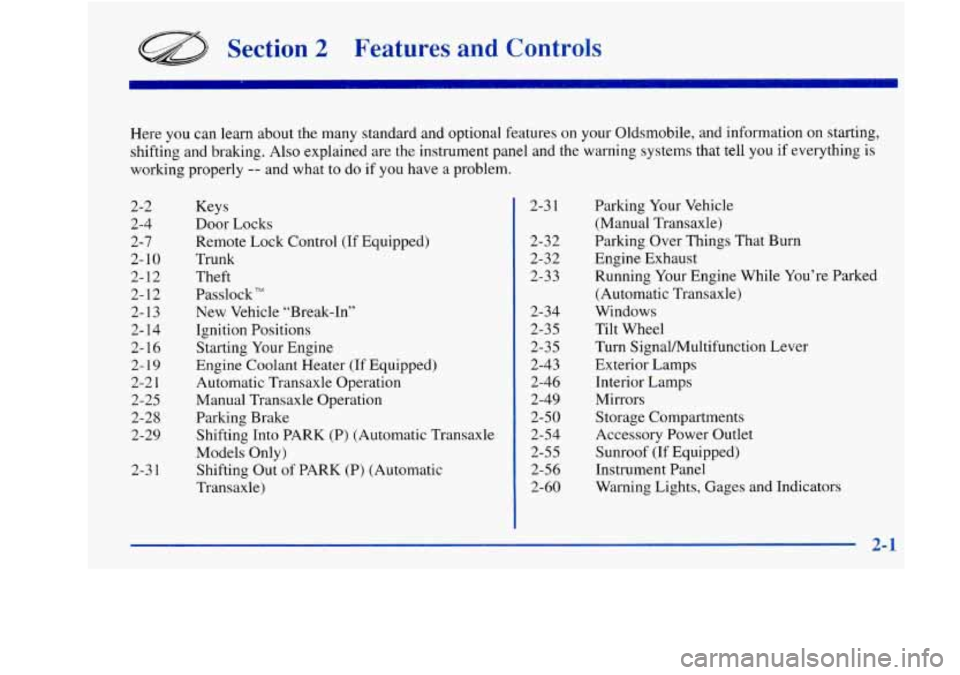
Section 2 Features and Controls
Here you can learn about the many standard and optional features on your Oldsmobile, and information on starting,
shifting and braking.
Also explained are the instrument panel and the warning systems that tell you if everything is
working properly -- and what to do if you have a problem.
2-2 2-4
2-7
2-10
2-12 2-12
2-13 2-14
2-
16
2-19
2-2
1
2-25 2-28 2-29
2-3
1
Keys
Door Locks
Remote Lock Control (If Equipped)
Trunk
Theft Passlock
TM
New Vehicle “Break-In”
Ignition Positions
Starting Your Engine
Engine Coolant Heater (If Equipped)
Automatic Transaxle Operation
Manual Transaxle Operation
Parking Brake
Shifting Into PARK (P) (Automatic Transaxle
Models Only) Shifting Out
of PARK (P) (Automatic
Transaxle) 2-3
1
2-32
2-32
2-33
1 2-34
1, 2-35
2-35
2-43
2-46
2-49
2-50
2-54
2-55
2-56
2-60 Parking
Your Vehicle
(Manual Transaxle)
Parking Over Things That Burn
Engine Exhaust
Running Your Engine While You’re Parked
(Automatic Transaxle)
Windows
Tilt Wheel
Turn SignalMultifunction Lever
Exterior Lamps
Interior Lamps
Mirrors
Storage Compartments
Accessory Power Outlet
Sunroof (If Equipped)
Instrument Panel
Warning Lights, Gages and Indicators
Page 75 of 372
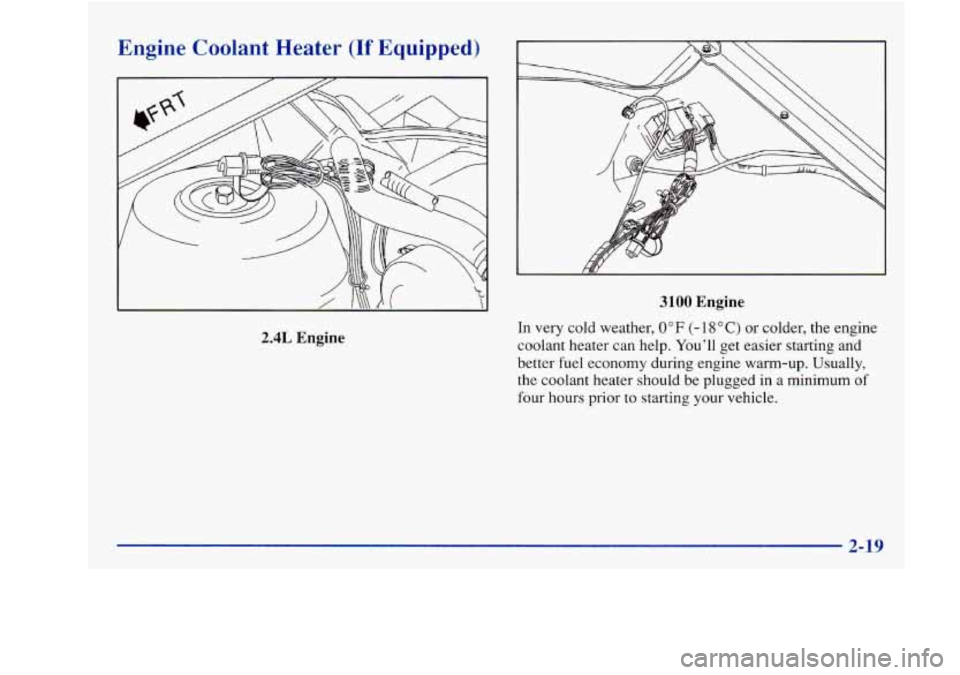
Engine Coolant Heater (If Equipped)
2.4L Engine
3100 Engine
In very cold weather, 0°F (- 18 "C) or colder, the engine
coolant heater can help. You'll get easier starting and
better
fuel economy during engine warm-up. Usually,
the coolant heater should be plugged in a minimum
of
four hours prior to starting your vehicle.
Page 76 of 372

To Use the Coolant Heater
1. Turn off the engine.
2. Open the hood and unwrap the electrical cord.
3. Plug it into a normal, grounded 110-volt AC outlet.
ION:
Plugging the cord into an ungrounded outlet
could cause an electrical shock.
Also, the wrong
kind
of extension cord could overheat and cause
a fire. You could be seriously injured. Plug the
cord into
a properly grounded three-prong
110-volt
AC outlet. If the cord won’t reach, use a
heavy-duty three-prong extension cord rated for
at least 15 amps.
4. Before starting the engine, be sure to unplug and store
the cord
as it was before to keep it away from moving
engine parts.
If you don’t, it could be damaged.
How long should you keep the coolant heater plugged
in? The answer depends on the outside temperature, the
kind
of oil you have, and some other things. Instead of
trying to list everything here, we ask that you contact
your Oldsmobile retailer in the area where
you’ll be
parking your vehicle. The retailer can give you the best
advice for that particular area.
2-20
Page 121 of 372
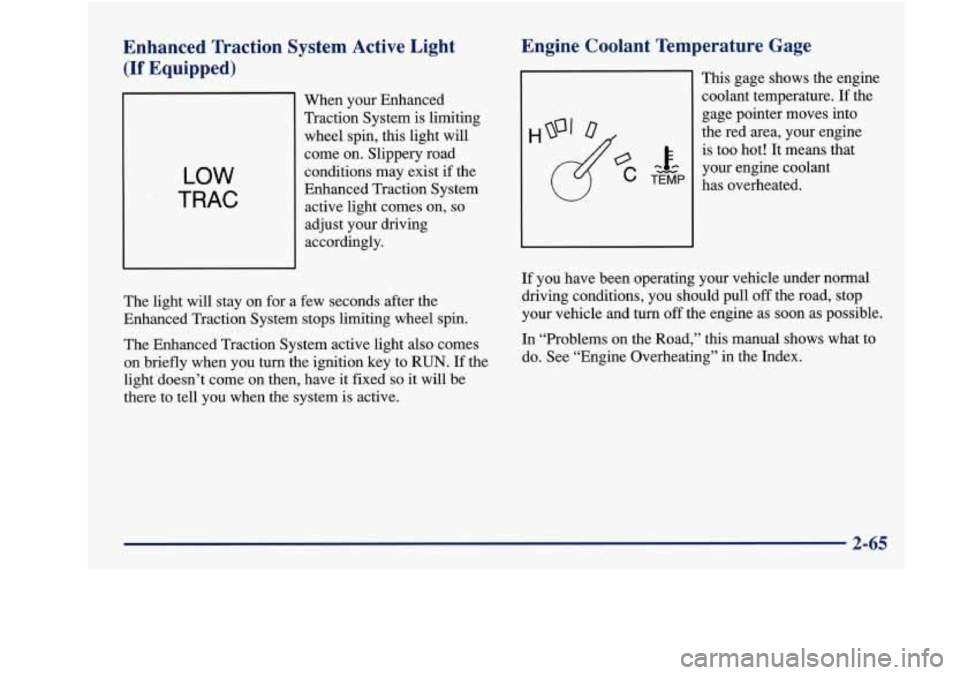
Enhanced Traction System Active Light
(If Equipped)
LOW
TRAC
When your Enhanced
Traction System is limiting
wheel spin, this light will
come on. Slippery road
conditions may exist
if the
Enhanced Traction System active light comes on,
so
adjust your driving
accordingly.
Engine Coolant Temperature Gage
W
This gage shows the engine
coolant temperature.
If the
gage pointer moves into
the red area, your engine
is too hot! It means that
your engine coolant
has overheated.
The light will stay on for a few seconds after the
Enhanced Traction System stops limiting wheel spin.
The Enhanced Traction System active light also comes on briefly when you turn the ignition key to RUN.
If the
light doesn’t come on then, have it fixed
so it will be
there to tell you when the system is active. If
you have been operating
your vehicle under normal
driving conditions, you should pull
off the road, stop
your vehicle and turn
off the engine as soon as possible.
In “Problems on the Road,” this manual shows what to
do. See “Engine Overheating” in the Index.
2-65
Page 122 of 372
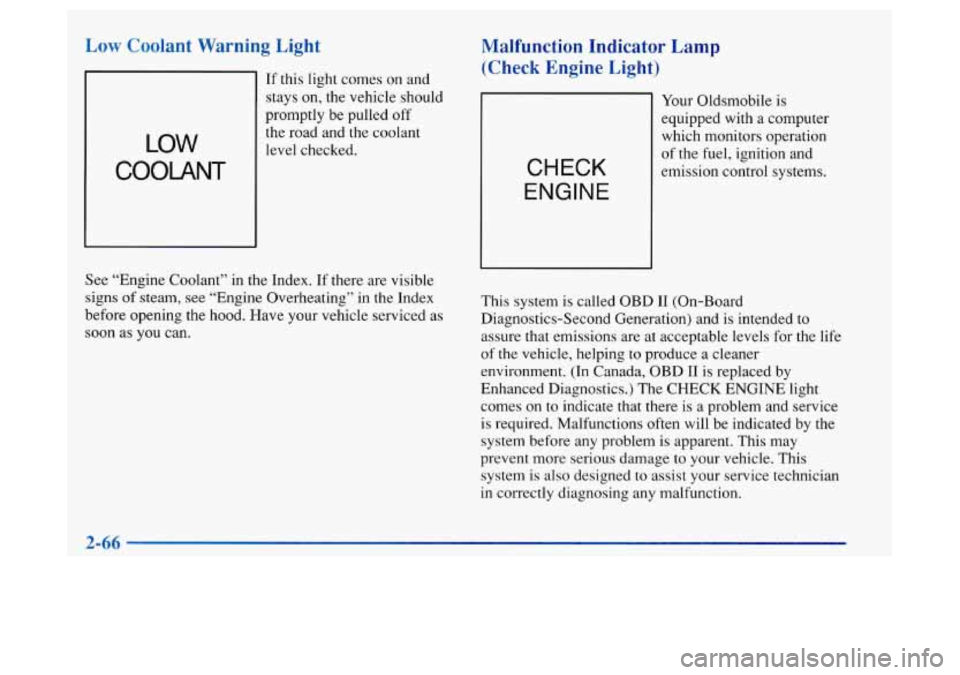
Low Coolant Warning Light
--I If this light comes on and
LOW
COOLANT
stays on, the vehicle should
promptly be pulled off
the road and the coolant
level checked.
See “Engine Coolant’’ in the Index. If there are visible
signs
of steam, see “Engine Overheating” in the Index
before opening the hood. Have your vehicle serviced as
soon as you can.
Malfunction Indicator Lamp
(Check Engine
Light)
CHECK
ENGINE
Your Oldsmobile is
equipped with a computer
which monitors operation
of the fuel, ignition and
emission control systems.
This system
is called OBD I1 (On-Board
Diagnostics-Second Generation) and is intended to
assure that emissions are at acceptable levels for the life
of the vehicle, helping to produce a cleaner
environment.
(In Canada, OBD I1 is replaced by
Enhanced Diagnostics.) The CHECK ENGINE light
comes on to indicate that there is a problem and service
is required. Malfunctions often will be indicated by
the
system before any problem is apparent. This may
prevent more serious damage to your vehicle. This
system is also designed to assist your service technician
in correctly diagnosing any malfunction.
2-64
Page 133 of 372
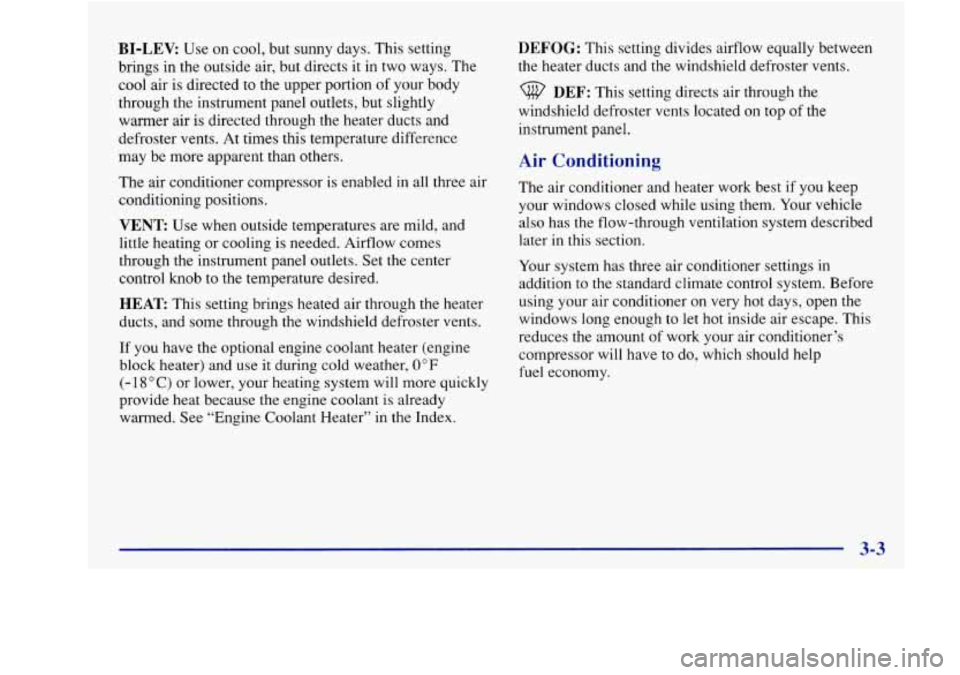
BI-LEV: Use on cool, but sunny days. This setting
brings in the outside air, but directs
it in two ways. The
cool air is directed to the upper portion of your body
through the instrument panel outlets, but slightly
warmer air is directed through the heater ducts and
defroster vents. At times this temperature difference
may be more apparent than others.
The air conditioner compressor
is enabled in all three air
conditioning positions.
VENT Use when outside temperatures are mild, and
little heating or cooling is needed. Airflow comes
through the instrument panel outlets. Set the center
control knob to the temperature desired.
HEAT This setting brings heated air through the heater
ducts, and some through the windshield defroster vents.
If you have the optional engine coolant heater (engine
block heater) and use it during cold weather,
0°F
(- 18 O C) or lower, your heating system will more quickly
provide heat because the engine coolant is already
warmed. See “Engine Coolant Heater” in the Index.
DEFOG: This setting divides airflow equally between
the heater ducts and the windshield defroster vents.
DEF: This setting directs air through the
windshield defroster vents located on top
of the
instrument panel.
Air Conditioning
The air conditioner and heater work best if you keep
your windows closed while using them. Your vehicle
also has the flow-through ventilation system described
later in this section.
Your system has three air conditioner settings in
addition to the standard climate control system. Before
using your air conditioner on very hot days, open the
windows long enough
to let hot inside air escape. This
reduces the amount
of work your air conditioner’s
compressor will have to do, which should help
fuel economy.
Page 134 of 372

Heating
On cold days, use HEAT with the temperature knob all
the way in the red area. The system will bring in outside
air, heat
it and send it to the floor ducts.
If your vehicle has an engine coolant heater, you can use
it to help your system provide warm air faster when it’s
cold outside
(O’F (-18°C) or lower). An engine coolant
heater warms
the coolant your engine and heating
system use to provide heat. See “Engine Coolant
Heater” in the Index.
Defogging and Defrosting
There are two settings for clearing your windows. For
each setting, adjust the temperature control as desired.
To rapidly defrost the windshield, rotate the temperature
control to maximum heat and rotate the mode control to
the defrost symbol. Rotate the
fan to the highest speed.
Your vehicle is equipped with side window defogger
vents. The side window defogger vents are located on
each end of the instrument panel. For additional side
window defogging, rotate the mode control to the
BI-LEV position, rotate the fan control to the highest
speed and aim the side vents on the instrument panel to
the side window. For increased airflow to the side vents,
close the center vents.
3-4
Page 209 of 372
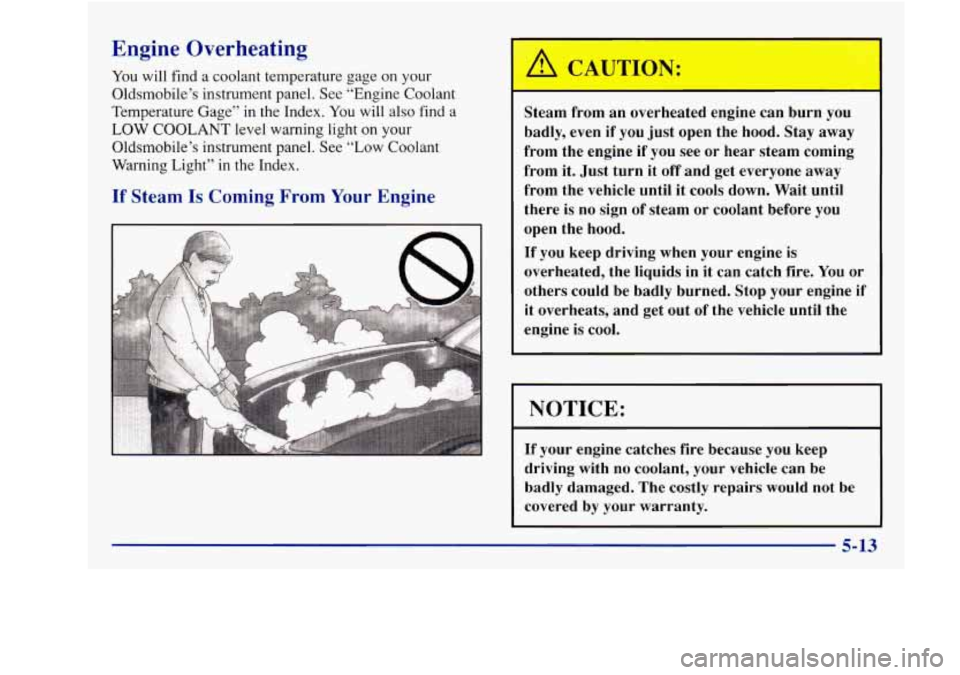
Engine Overheating
You will find a coolant temperature gage on your
Oldsmobile’s instrument panel. See “Engine Coolant
Temperature Gage” in the Index.
You will also find a
LOW COOLANT level warning light on your
Oldsmobile’s instrument panel. See “Low Coolant
Warning Light” in the Index.
If Steam Is Coming From Your Engine
/r CAUTION:
Steam from an overheated engine can burn you
badly, even
if you just open the hood. Stay away
from the engine if you see or hear steam coming
from it. Just turn it
off and get everyone away
from the vehicle until it cools down. Wait until
there is no sign of steam or coolant before
you
open the hood.
If you keep driving when your engine is
overheated, the liquids in it can catch fire. You or
others could be badly burned. Stop your engine if
it overheats, and get out of the vehicle until the
engine is cool.
I i
NOTICE:
If your engine catches fire because you keep
driving with no coolant, your vehicle can be
badly damaged. The costly repairs would not be
covered by your warranty.
Page 211 of 372

When you decide it's safe to lift the hood, here's what
you'll see:
2.4L Engine
3100 Engine
A. Coolant Surge Tank with Pressure Cap
B. Electric Engine Fan
An electric fan under the hood can start up even
when the engine
is not running and can injure
you. Keep hands, clothing and tools away from
any underhood electric fan.
5-15